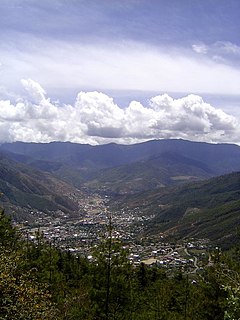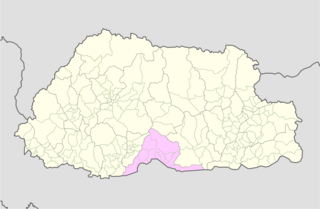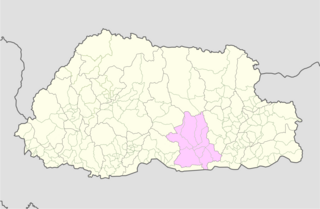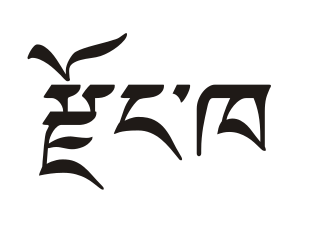
Chukha District is one of the 20 dzongkhag (districts) comprising Bhutan. The major town is Phuentsholing which is the gateway city along the sole road which connects India to western Bhutan. Chukha is the commercial and the financial capital of Bhutan. With Bhutan's oldest hydropower plant, Chukha hydel, and Tala Hydroelectricity Project, the country's largest power plant, Chukha is the dzongkhag which contributes the most to the GDP of the country. Also located in Chukha district are some of the country's oldest industrial companies like the Bhutan Carbide Chemical Limited (BCCL) and the Bhutan Boards Products Limited (BBPL).

Gasa District or Gasa Dzongkhag is one of the 20 dzongkhags (districts) comprising Bhutan. The northern part of Gasa District is a disputed zone under the control of the People's Republic of China. The capital of Gasa District is Gasa Dzong near Gasa. It is located in the far north of the county and spans the Middle and High regions of the Tibetan Himalayas. The dominant language of the district is Dzongkha, which is the national language. Related languages, Layakha and Lunanakha, are spoken by semi-nomadic communities in the north of the district.

Tsirang District, is one of the 20 dzongkhags (districts) of Bhutan. The administrative center of the district is Damphu

A gewog, in the past also spelled as geog, refers to a group of villages in Bhutan. The head of a gewog is called a gup. Gewogs form a geographic administrative unit below dzongkhag districts, and above Dzongkhag Thromde class B and Yenlag Thromde municipalities. Dzongkhag Thromde class A municipalities have their own independent local government body.

Thimphu District is a dzongkhag (district) of Bhutan. Thimphu is also the capital of Bhutan and the largest city in the whole kingdom.

Getena Gewog is a gewog of Chukha District, Bhutan. The gewog has an area of 214 square kilometres. It contains 7 villages and 118 households.

Dala Gewog is a gewog of Chukha District, Bhutan. The gewog has an area of 139.7 square kilometres and contains 7 villages. Dala Gewog is part of Phuentsholing Dungkhag, along with Logchina and Phuentsholing gewogs.

Dungna Gewog is a gewog of Chukha District, Bhutan. The gewog has an area of 165.4 square kilometres and contains 9 villages.

Phuentsholing Gewog is a gewog of Chukha District, Bhutan. The gewog has an area of 139.8 square kilometres and contains 19 villages. Phuentsholing Gewog is part of Phuentsholing Dungkhag, along with Dala, Logchina Gewogs and Shampheling Gewog. It is one of the highest populated gewog in Chukha Dzongkhag.

Bji Gewog is a gewog of Haa District, Bhutan. In 2002 before substantial border changes the gewog had an area of 832 square kilometres and contained 8 villages and 234 households.

Katsho Gewog is a gewog of Haa District, Bhutan. Before substantial border changes, the gewog in 2007 had an area of 42.3 square kilometres and contained 10 villages and 247 households.

Lamgong Gewog is a gewog of Paro District, Bhutan. The gewog had an area of 48.8 square kilometres in 2002, and contained eight villages and 348 households.

Wangchang Gewog is a gewog of Paro District, Bhutan. In 2002, the gewog had an area of 34.2 square kilometres and contained 7 chewogs and 278 households.

Soe Gewog is a gewog of Thimphu District, Bhutan. Soe Gewog, along with Naro and Lingzhi Gewogs, is part of Lingzhi Dungkhag.

Sherzhong Gewog is a gewog of Sarpang District, Bhutan. Serzhong Gewog, together with Bhur, Taklai, and Gelephu Gewogs, belongs to Gelephu Dungkhag.

Goshing Gewog is a gewog of Zhemgang District, Bhutan. Goshing Gewog is also a part of Panbang Dungkhag (sub-district), along with Bjoka, Ngangla, and Phangkhar Gewogs.

Chali Gewog is a gewog of Mongar District, Bhutan. In 2002, the gewog contained 263 households and covered an area of 42 square kilometres.

Norbugang Gewog is a gewog of Pemagatshel District, Bhutan. Norbugang Gewog is part of Nganglam Dungkhag, along with Dechenling and Nganglam Gewogs.

Dechheling Gewog is a gewog of Pemagatshel District, Bhutan. Dechenling Gewog is part of Nganglam Dungkhag, along with Nganglam and Norbugang Gewogs.

Thrimshing Gewog is a gewog of Trashigang District, Bhutan. Thrimshing Gewog, along with Kangpara Gewog, comprises Thrimshing Dungkhag (sub-district)















